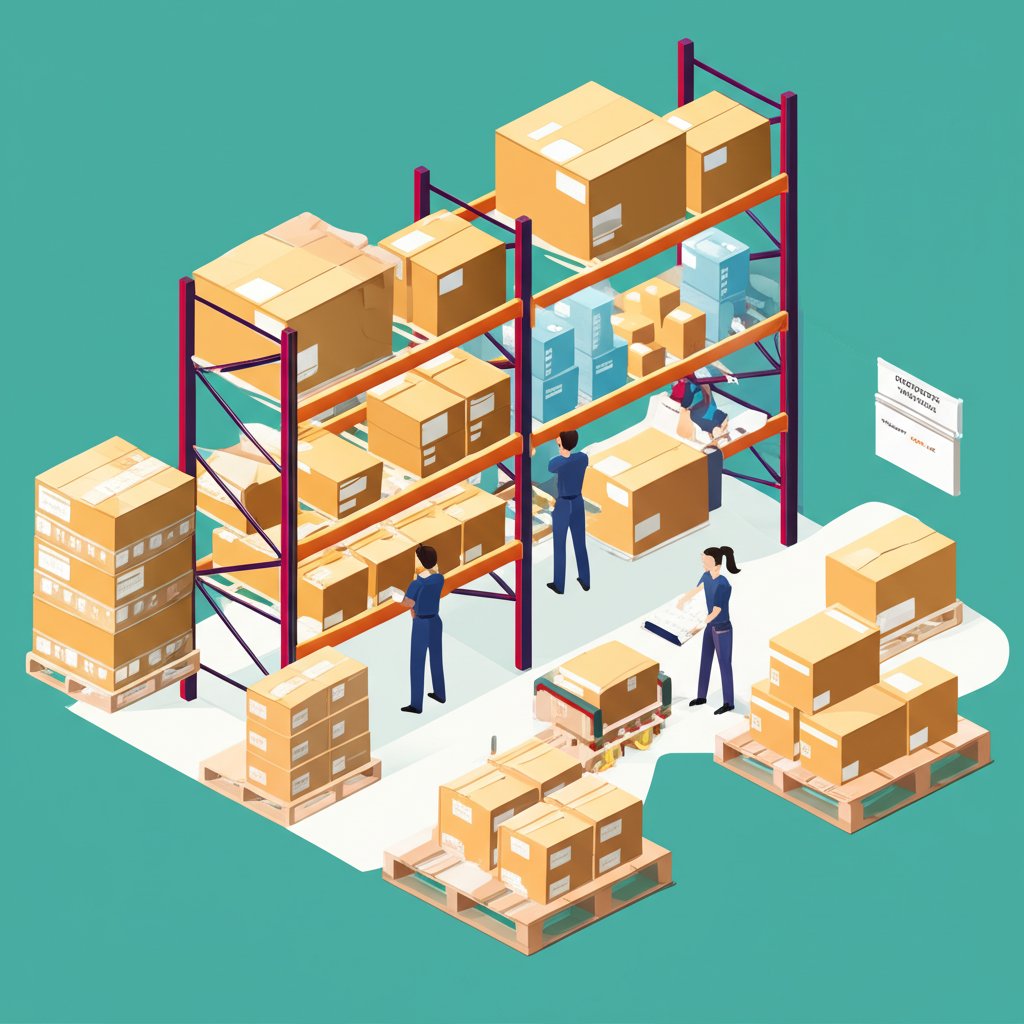
Introduction to Amazon FBA Inspection
Imagine a world where your products reach customers seamlessly, where quality issues are a distant memory. This is the promise of Amazon FBA (Fulfillment by Amazon), a service that allows sellers to leverage Amazon’s vast logistics network to store, pack, and ship products. But how do you ensure your products meet the high standards required? Enter Amazon FBA Inspection, a crucial step in safeguarding your business’s reputation and success.
Amazon FBA Inspection is more than just a precaution—it’s a necessity. This process involves thorough checks conducted before your products leave the factory, ensuring they meet Amazon’s stringent quality and packaging standards. By investing in robust pre-shipment inspections, sellers can prevent costly returns, avoid negative reviews, and protect their seller reputation. This proactive approach is essential for maintaining customer satisfaction and ensuring compliance with Amazon’s standards.
Neglecting quality control can lead to dire consequences. Imagine receiving a flood of negative reviews, or worse, facing increased A-to-Z claims that could result in account suspension. These scenarios highlight the importance of FBA quality control, where every detail matters—from product packaging to labeling and functionality. By implementing a comprehensive Amazon FBA Inspection process, sellers can navigate these challenges effectively.
In this guide, we’ll explore the intricacies of Amazon FBA Inspection, providing you with the tools and knowledge to maintain high standards and ensure your products shine in the competitive Amazon marketplace. Whether you’re a seasoned seller or new to the platform, understanding and executing a robust inspection process is key to long-term success.
The Importance of Quality Control for FBA Sellers
As an Amazon FBA seller, the quality of your products is your lifeline to success. Imagine a scenario where a customer receives a product that doesn’t meet their expectations. The impact is immediate: a negative review, a return request, and a potential hit to your seller ratings. This is why quality control for FBA is not just advisable; it’s essential.
Why Quality Control Cannot Be Overlooked
Quality control directly influences customer satisfaction and, by extension, your FBA seller reputation. High-quality products lead to positive reviews and repeat purchases, which are crucial for maintaining a competitive edge on Amazon. In contrast, poor quality can lead to negative feedback, decreased sales velocity, and even account suspension.
Proactive quality control through inspections helps build brand trust and fosters customer loyalty. By ensuring that products meet specified standards before they reach Amazon’s warehouses, you mitigate the risk of defects and non-compliance issues that could otherwise harm your business.
The Costs of Ignoring Quality Control
Neglecting quality control can be costly. Consider the financial implications of returns and refunds, which not only affect your bottom line but can also incur disposal fees if products are unsellable. Moreover, a damaged reputation due to consistent quality issues can lead to a decline in customer trust and sales.
In fact, the investment in quality control is a small price to pay compared to the potential losses from poor product quality. Implementing a robust inspection process ensures that your products align with Amazon’s standards, avoiding the pitfalls of negative reviews and maintaining a strong seller reputation.
In summary, quality control for FBA sellers is a strategic move that protects your business from the adverse effects of poor product quality. By prioritizing inspections and maintaining high standards, you not only safeguard your reputation but also enhance your brand’s credibility in the competitive Amazon marketplace.

What an Amazon FBA Inspection Actually Involves
When you think about ensuring product quality for your Amazon FBA business, you might wonder, ‘What exactly does an Amazon FBA inspection entail?’ The answer lies in a structured process designed to verify that your products meet the necessary standards before they reach Amazon’s fulfillment centers.
Types of Inspections in the FBA Inspection Process
Several types of inspections are crucial for FBA sellers, each serving a specific purpose in quality assurance:
- Pre-Shipment Inspection (PSI): This is the most common type of inspection, conducted when 100% of the goods are manufactured and at least 80% are packed. It ensures that the final products meet your specifications and quality standards before they leave the factory.
- During Production Inspection (DPI): Conducted when 10-50% of the production is complete, this inspection helps identify and rectify defects early in the manufacturing process.
- Container Loading Check (CLC): This inspection occurs during the loading phase to verify the quantity and quality of products, ensuring they are packed correctly and securely for shipment.
Each inspection type plays a vital role in the FBA inspection process, helping to maintain product quality and compliance with Amazon’s standards.
Common Checks in an Amazon FBA Product Inspection
An Amazon FBA product inspection covers various checkpoints to ensure that finished goods meet all requirements. Here are some common checks:
- Quantity Verification: Confirms that the correct number of products is produced and packed.
- Workmanship: Checks for any visible defects or inconsistencies in the product’s finish.
- Color and Size: Ensures that the products match the specified color and size requirements.
- Labeling: Verifies that all labels, including FNSKU numbers, are correctly applied and comply with Amazon’s guidelines.
- Packaging: Inspects packaging for durability and compliance with Amazon’s standards to prevent damage during transit.
- Basic Function Tests: For functional items, tests are conducted to ensure they operate as intended.
One of the methodologies used during inspections is the Acceptable Quality Limit (AQL) sampling. This statistical tool helps determine the maximum number of defective units allowed in a sample size, ensuring that the batch meets predefined quality standards.
By understanding these facets of an Amazon FBA inspection, sellers can better prepare their products to meet Amazon’s requirements, ultimately leading to fewer returns and higher customer satisfaction. In the next section, we’ll explore how to find reliable inspection services, particularly when sourcing products from China.
Finding Reliable FBA Inspection Services in China
When it comes to ensuring the quality of your Amazon products, particularly those manufactured in China, choosing the right inspection service is crucial. Imagine you’re sourcing a new product line and need to ensure it meets Amazon’s stringent requirements. This is where a third-party China FBA inspection service becomes invaluable. But how do you navigate the myriad of options available?
Why Third-Party Inspections Are Essential
China is a global manufacturing hub, but the perception of quality can vary significantly between suppliers. Engaging a third-party inspection service ensures that your products are thoroughly checked before they leave the factory. This proactive step helps avoid the costly repercussions of shipping defective goods, such as negative reviews and returns, which can damage your seller reputation.
Third-party inspections provide an unbiased evaluation of your products, checking for defects, verifying quantities, and ensuring compliance with Amazon’s FBA guidelines. This is particularly important for maintaining inventory quality and avoiding issues that could arise from non-compliance with Amazon’s standards.
Challenges and Considerations
Finding the right inspection service in China can be daunting. The market is saturated with providers, and not all offer the same level of service. Here are some considerations to keep in mind:
- Experience and Expertise: Look for companies with a proven track record in your product category. Experience in handling Amazon FBA inspections is crucial.
- Proximity to Suppliers: Choose a service located near your manufacturing site to reduce travel costs and inspection delays.
- Comprehensive Services: Ensure the provider offers a full range of checks, including pre-shipment and during-production inspections.
- Reputation: Check reviews and testimonials from other Amazon sellers to gauge reliability and service quality.
Tips for Vetting Inspection Companies
To find a reliable inspection partner, follow these steps:
- Set Your Budget: Determine how much you’re willing to spend on inspections. This will help narrow down your options.
- Research and Shortlist: Use resources like Sermondo to find and compare inspection companies. Look for those that specialize in Amazon FBA requirements.
- Request Proposals: Contact shortlisted companies to get detailed proposals outlining their services and costs.
- Conduct Interviews: Arrange video calls to assess communication skills and get a feel for their professionalism.
- Check Credentials: Verify that the company employs certified inspectors and follows international quality standards.
Spotlight on Eagle Eyes Quality Inspection
Among the many options, Eagle Eyes Quality Inspection stands out for its comprehensive services tailored to Amazon FBA sellers. Their inspection process covers all necessary checks, from barcode and labeling verification to packaging and functionality tests. By ensuring compliance with Amazon’s FBA requirements, they help sellers avoid costly rejections and protect their seller reputation.
Choosing the right inspection service is a strategic decision that can significantly impact your business’s success. By investing in a reliable China FBA inspection partner, you ensure that your products meet the highest standards, paving the way for a successful Amazon FBA venture. In the next section, we’ll explore inspection options available within the USA and compare them to those in China.
Exploring FBA Inspection Options Within the USA
When it comes to ensuring the quality of your products, the location of your inspection service can make a significant difference. While many sellers opt for inspections in the country of origin, there are compelling reasons to consider FBA inspection USA. But when is a USA-based inspection the right choice for your Amazon FBA business?
Why Choose USA-Based Inspections?
There are several scenarios where conducting inspections in the USA might be more advantageous. One primary reason is when goods are imported from multiple countries and consolidated in the U.S. before being sent to Amazon’s fulfillment centers. In such cases, a final check in the USA ensures that all products meet quality standards before reaching the customer.
Another scenario is when products are domestically manufactured. Conducting inspections locally can be more convenient and ensures compliance with both Amazon’s standards and U.S. regulations. Moreover, having a USA-based inspection can serve as a final quality assurance step, catching any issues that may have been missed earlier.
Types of USA-Based FBA Inspection Services
USA-based inspection services typically cover a range of checks similar to those in origin countries. These include:
- Final Random Inspection (FRI): A comprehensive check of a random sample from the shipment to ensure quality and compliance.
- Pre-Amazon Check: Ensures that products are correctly labeled and packaged according to Amazon’s requirements.
- Functionality Testing: Verifies that products function as intended, which is crucial for electronics and other functional items.
- Packaging Inspection: Checks that packaging materials are robust enough to prevent damage during transit.
Comparing USA-Based and Origin-Country Inspections
Choosing between USA-based and origin-country inspections depends on various factors, including cost, convenience, and the specific needs of your business. Let’s compare the two:
| Aspect | USA-Based Inspection | Origin-Country Inspection |
|---|---|---|
| Cost | Generally higher due to labor costs | Often lower, especially in countries like China |
| Convenience | Ideal for final checks and consolidations | Best for early-stage defect identification |
| Compliance | Ensures adherence to U.S. regulations | Focuses on manufacturing standards |
| Timing | May delay shipment if issues are found | Allows for early correction of defects |
Pros and Cons of USA-Based Inspections
Pros:
- Ensures compliance with U.S. standards
- Convenient for final checks and consolidation
- Reduces risk of customer returns due to missed defects
Cons:
- Higher costs compared to inspections in origin countries
- Potential delays in shipment if issues are identified
In conclusion, while USA-based inspections come with higher costs, they offer peace of mind, especially when consolidating products from various sources or ensuring compliance with U.S. standards. As you consider your options, weigh these factors carefully to determine the best inspection strategy for your Amazon FBA business. Next, we’ll delve into actionable tips for selecting the right FBA inspection partner to ensure your products meet Amazon’s exacting standards.
Tips for Selecting Your FBA Inspection Partner
When it comes to selecting an Amazon FBA inspection service, the stakes are high. Imagine the peace of mind knowing your products are in compliance with Amazon’s standards before they even leave the factory. To achieve this, choosing the right inspection partner is crucial. Here’s how you can make an informed decision.
Key Criteria for Evaluating Inspection Companies
Finding the right partner involves evaluating several critical criteria:
- Experience and Expertise: Seek companies with a proven track record in your specific product category. Experience with Amazon FBA inspections is particularly beneficial, ensuring familiarity with Amazon’s guidelines.
- Reputation: Check reviews and testimonials from other sellers. A company with a good reputation is likely to provide reliable services.
- Quality of Reporting: Ensure the company provides detailed inspection reports. This documentation is crucial for understanding any issues and taking corrective actions.
- Pricing: While cost is a factor, it shouldn’t be the sole consideration. Balance cost with the quality of service offered.
- Compliance Understanding: The provider should have a thorough understanding of Amazon’s specific requirements, ensuring all inspections meet these standards.
Assessing the Right Fit: LLC vs. Larger Firms
Deciding between an FBA inspection LLC or a larger firm depends on your specific needs:
- LLCs: Often offer personalized service and flexibility. They may be more agile and responsive to specific requirements.
- Larger Firms: Typically have more resources and a broader range of services. They might be better suited for businesses with extensive inspection needs.
Consider the scale of your operations and the complexity of your product line when making this choice.
Questions to Ask Potential Inspection Partners
Before finalizing your decision, ask potential partners these important questions:
- How familiar are you with Amazon’s FBA requirements?
- Can you provide references from other Amazon sellers?
- What is included in your inspection report and how detailed is it?
- How do you handle any issues found during an inspection?
- What is your pricing structure and are there any additional fees?
Spotlight on Eagle Eyes Quality Inspection
Leading the way in Amazon FBA inspections is Eagle Eyes Quality Inspection. Their comprehensive service ensures products meet Amazon’s stringent requirements, from barcode checks to packaging assessments. By choosing Eagle Eyes, you mitigate risks associated with non-compliance, safeguarding your seller account and enhancing customer satisfaction.
In conclusion, selecting the right FBA inspection partner is a strategic decision that can significantly impact your business. By prioritizing experience, reputation, and a thorough understanding of Amazon’s requirements, you can ensure your products are always inspection-ready. Next, we will clarify Amazon’s role in inspecting your FBA shipments directly.
Does Amazon Inspect Your FBA Shipments Directly?
One of the most common questions Amazon FBA sellers have is about Amazon’s role in inspecting FBA inventory. You might wonder, ‘Does Amazon inspect FBA inventory?’ or ‘Can you have Amazon inspect FBA inventory?’ Understanding Amazon’s inspection role is crucial for maintaining product quality and compliance.
While Amazon does perform random checks on products to ensure compliance with their standards, they do not provide a comprehensive quality control service for sellers. These checks are primarily to verify that products meet Amazon’s guidelines for safety, labeling, and packaging. However, they are not a substitute for a thorough pre shipment inspection conducted by the seller or a third-party service.
Amazon’s Limited Inspection Role
Amazon’s random inspections are designed to catch any glaring compliance issues that might affect customer safety or satisfaction. For example, if a product is found to be mislabeled or improperly packaged, Amazon might flag it. However, these checks are not exhaustive and do not cover every aspect of quality control, such as verifying the product’s functionality or checking for minor defects.
This limited inspection role means that the onus of ensuring product quality lies squarely on the seller. It’s the seller’s responsibility to conduct a comprehensive Amazon FBA inventory inspection before products are shipped to Amazon’s fulfillment centers. This proactive approach helps prevent issues that could lead to negative reviews or returns, ultimately protecting the seller’s reputation and account status.
The Importance of Seller-Driven Quality Control
Given Amazon’s limited inspection role, sellers must prioritize their own quality control processes. This involves conducting thorough inspections at various stages of production and before the final shipment to Amazon. By doing so, sellers can identify and rectify any defects or compliance issues early, ensuring that only high-quality products reach customers.
Consider using third-party inspection services to bolster your quality control efforts. These services offer unbiased evaluations and can conduct detailed checks that go beyond Amazon’s random inspections. By investing in a robust inspection process, you not only comply with Amazon’s standards but also enhance customer satisfaction and loyalty.
In conclusion, while Amazon does play a role in ensuring compliance through random checks, the comprehensive quality control of your products is your responsibility as a seller. By understanding and acting on this, you can maintain high standards and avoid potential pitfalls associated with poor product quality. Next, we’ll guide you through the step-by-step process of a typical third-party FBA inspection, ensuring your products are always inspection-ready before reaching Amazon.

A Walkthrough of the Typical FBA Inspection Process
Embarking on the journey of a third-party FBA inspection might seem daunting, but breaking it down into manageable steps can simplify the process. Here’s a detailed guide to help you navigate through a typical FBA inspection process, ensuring your products meet Amazon’s high standards before they hit the shelves.
1. Booking the Inspection
The first step in the FBA inspection process is booking your inspection service. Start by selecting a reputable third-party inspection company, ensuring they have experience with Amazon FBA requirements. When booking, communicate your specific inspection needs, including the type of inspection required, the timeline, and any particular concerns you have about your products.
2. Providing Product Specifications and Checklists
Once the inspection is scheduled, it’s crucial to provide the inspection company with detailed product specifications and an inspection checklist. This checklist should include all relevant product details such as dimensions, functionalities, packaging requirements, and labeling standards. The more comprehensive the information, the more effectively the inspectors can perform their tasks, ensuring all aspects of the product meet Amazon’s standards.
3. The On-Site Inspection
During the on-site inspection, inspectors visit the manufacturing site to conduct a thorough examination of your products. This includes verifying the quantity, checking for defects, and ensuring compliance with your specified requirements. Inspectors will perform various tests, such as functionality checks and packaging assessments, to confirm that the products are ready for Amazon’s fulfillment centers.
4. Receiving and Interpreting the Inspection Report
After the inspection, you will receive a detailed report outlining the findings. This report will specify any issues detected, such as defects or non-compliance with standards, and provide recommendations for corrective actions. It’s essential to carefully review this report to understand the current status of your products and decide on any necessary follow-up actions.
5. Taking Corrective Actions
Based on the inspection report, you may need to address certain issues before proceeding with shipment. This could involve correcting defects, adjusting packaging, or even conducting a re-inspection if significant problems are found. Taking these steps ensures that your products meet all quality standards, reducing the risk of returns and negative reviews.
By following these steps, you can ensure a smooth and effective third-party FBA inspection process. This proactive approach not only helps in maintaining product quality but also enhances customer satisfaction and protects your seller reputation. In the next section, we’ll discuss how to prepare your inventory for a successful FBA inspection, ensuring your products are always inspection-ready.
Preparing Your Inventory for a Successful FBA Inspection
Imagine sending your products off to Amazon, only to find they fall short of the standards expected. To avoid such pitfalls, meticulous preparation is key in the FBA inspection process. Proper preparation ensures that your products meet Amazon’s stringent requirements, minimizing the risk of negative reviews and returns.
Setting Clear Product Specifications
The foundation of effective FBA inspection preparation lies in setting clear and detailed product specifications. This includes defining dimensions, materials, colors, and any other critical features. These specifications serve as a benchmark during inspections, ensuring that every item meets the expected standards. Providing your supplier with these specifications helps prevent misunderstandings and ensures that the production aligns with your expectations.
Creating an Effective Inspection Checklist
Developing a comprehensive FBA inspection checklist is crucial. This checklist should cover all aspects of your product, including:
- Quality Standards: Define what constitutes acceptable quality, including tolerances for minor defects.
- Packaging and Labeling: Ensure that packaging meets Amazon’s guidelines and that all labels are correctly applied.
- Functionality: Include tests to verify that the product functions as intended, especially for electronics or mechanical items.
- Safety Compliance: Confirm that products meet all safety standards relevant to your category.
By tailoring this checklist to your specific product, you ensure a thorough inspection process that addresses all potential issues.
Communicating with Your Supplier
Effective communication with your supplier is vital. Clearly convey your expectations and inspection requirements. Regular updates and feedback loops can help identify and resolve issues early, preventing defects from reaching the inspection stage. Establishing a strong relationship with your supplier can lead to better cooperation and adherence to your quality standards.
Avoiding Common Pitfalls
Several common pitfalls can lead to inspection failure. These include inadequate specifications, lack of clear communication, and insufficient sampling. To avoid these, ensure that your specifications are detailed and that you maintain ongoing dialogue with your supplier. Implementing an AQL sampling method can also help in identifying defects early, ensuring that the majority of your products meet the desired quality.
In conclusion, thorough preparation is the key to a successful FBA inspection. By setting clear specifications, creating a detailed checklist, and maintaining open communication with your supplier, you can ensure that your products are ready for Amazon’s fulfillment centers. This proactive approach not only enhances product quality but also protects your seller reputation and boosts customer satisfaction. As you prepare for your next shipment, remember that a well-prepared inventory is your best defense against potential inspection failures.
Conclusion
Imagine the peace of mind that comes with knowing your products meet the highest standards before they even reach Amazon’s fulfillment centers. This is the essence of Amazon FBA Inspection—a crucial investment in the quality control process that safeguards your business’s reputation and ensures customer satisfaction.
The importance of FBA inspection cannot be overstated. As we’ve explored throughout this guide, thorough inspections are vital for maintaining product quality, preventing costly returns, and protecting your seller reputation. By implementing a robust inspection strategy, you not only comply with Amazon’s stringent standards but also foster trust and loyalty among your customers.
Why Quality Control is a Smart Investment
Investing in quality control is akin to securing your business’s future. By addressing potential issues before they escalate, you minimize the risk of negative reviews and returns, which can significantly impact your bottom line. A well-executed inspection process ensures that your products are consistently high-quality, enhancing your brand’s credibility in the competitive Amazon marketplace.
Moreover, by leveraging professional inspection services like Eagle Eyes Quality Inspection, you can streamline your quality control efforts. Their comprehensive checks cover everything from barcode and labeling verification to packaging and functionality tests, ensuring your products meet Amazon’s exacting requirements.
Taking Action: Review and Implement
Now is the time to take action. Review your current quality control processes and identify areas for improvement. Consider partnering with an experienced inspection service to enhance your product checks and ensure compliance with Amazon’s standards. By doing so, you safeguard your business against potential pitfalls and set the stage for long-term success.
In conclusion, the investment in Amazon FBA inspection is not just a cost—it’s a strategic move that pays dividends in customer satisfaction, brand reputation, and business sustainability. As you continue your journey in the Amazon marketplace, remember that quality control is your ally in building a thriving FBA business.
Amazon FBA Inspection FAQs
1. What is Amazon FBA inspection?
Amazon FBA inspection is a process conducted by third-party companies to ensure products meet Amazon’s quality standards before shipment. This includes checks on packaging, labeling, and product functionality to prevent issues like returns and negative reviews.
2. Does Amazon inspect FBA inventory?
Amazon performs random checks for compliance but does not offer comprehensive quality control for sellers. The responsibility for ensuring product quality lies with the seller, making third-party inspections crucial.
3. Why is quality control important for FBA sellers?
Quality control is vital for maintaining customer satisfaction, avoiding negative reviews, and protecting your seller reputation. It helps prevent costly returns and ensures compliance with Amazon’s standards.
4. What are the benefits of using Eagle Eyes Quality Inspection?
Eagle Eyes ensures products meet Amazon’s FBA requirements, reducing risks of non-compliance, protecting seller ratings, and enhancing customer satisfaction by conducting thorough inspections before shipment.
5. How do I choose the right FBA inspection partner?
Select a partner based on experience, reputation, and understanding of Amazon’s requirements. Consider their reporting quality and pricing to ensure they meet your specific needs.



